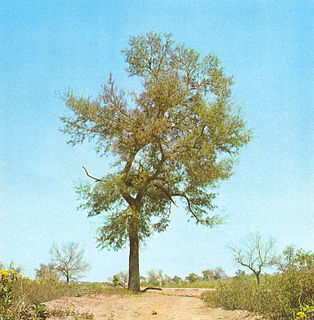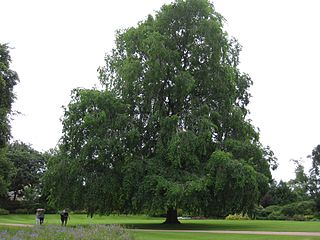
The Chaco National Park is a national park of Argentina, located in the province of Chaco. It has an area of 150 km2. It was created in 1954 in order to protect a sample of the Eastern Chaco, composed mainly of warm lowlands, with an annual summer rainfall between 750 and 1,300 mm.

Schinopsis lorentzii is a hardwood tree known as red quebracho, native of the Paraguayan subtropical area, which forms forests in Gran Chaco region of Argentina, in Paraguay, and Bolivia. Some of its common names are coronillo, quebracho Cornillo (Brazil), quebracho chaqueño, quebracho colorado santiagueño, quebracho macho, and quebracho bolí. The qualification colorado ("red") differentiates it from other species of common quebracho tree, the Aspidosperma quebracho-blanco. The indication santiagueño is made to distinguish it from quebracho colorado chaqueño, a closely related species.

Schinopsis is a genus of South American trees in the family Anacardiaceae, also known by the common names quebracho, quebracho colorado and red quebracho.

The Siberian Elm cultivar Ulmus pumila 'Pendula' is from northern China, where it is known as Lung chao yü shu. It was classified by Frank Meyer in Fengtai in 1908, and introduced to the United States by him from the Peking Botanical Garden as Weeping Chinese Elm. The USDA plant inventory record (1916) noted that it was a "rare variety even in China". It was confirmed as an U. pumila cultivar by Krüssmann (1962).
The American elm cultivar Ulmus americana 'Pendula' is considered probably just a forma by Green, although it was originally listed by William Aiton in Hort. Kew, 1: 320, 1789 as U. americana var. pendula, cloned in England in 1752 by James Gordon.

The Field Elm cultivar Ulmus minor 'Pendula' was said to have been raised in Belgium in 1863. It was listed as Ulmus sativa pendula by C. de Vos in 1887, and by Boom in 1959 as a cultivar.
The Wych Elm cultivar Ulmus glabra 'Pendula Variegata' was first described in 1850, and later by J. F. Wood in The Midland Florist and Suburban Horticulturist (1851) as U. montana pendula variegata, the 'broad-leaved variegated weeping mountain elm', and was said by him to have originated in and been distributed by the Pontey nursery of Kirkheaton, Huddersfield, Yorkshire. It was listed by Hartwig & Rümpler in Illustrirtes Gehölzbuch (1875) as Ulmus montana (:glabra) var. pendula variegataHort.

The elm cultivar Ulmus 'Scampstoniensis', the Scampston Elm or Scampston Weeping Elm, is said to have come from Scampston Hall, Yorkshire, England, before 1810. Loudon opined that a tree of the same name at the Royal Horticultural Society's Garden in 1834, 18 feet (5.5 m) high at 8 years old "differed little from the species". Henry described the tree, from a specimen growing in Victoria Park, Bath, as "a weeping form of U. nitens" [:Ulmus minor ]; however Green considered it "probably a form of Ulmus × hollandica". Writing in 1831, Loudon said that the tree was supposed to have originated in America. U. minor is not, however, an American species, so if the tree was brought from America, it must originally have been taken there from Europe. There was an 'American Plantation' at Scampston, which may be related to this supposition. A number of old specimens of 'Scampstoniensis' in this plantation were blown down in a great gale of October 1881; younger specimens were still present at Scampston in 1911.
Quebracho is a common name in Spanish to describe very hard wood tree species. The etymology of the name derived from quiebrahacha, or quebrar hacha, meaning "axe-breaker".

Ulmus × hollandica 'Wentworthii Pendula', commonly known as the Wentworth Elm or Wentworth Weeping Elm, is a cultivar with a distinctive weeping habit that appears to have been introduced to cultivation towards the end of the 19th century. Little is known of its history; the tree is not mentioned in either Elwes and Henry's or Bean's classic works on British trees. The earliest known references are Dutch and German, the first by de Vos in Handboek tot de praktische kennis der voornaamste boomen (1890). At about the same time, the tree was offered for sale by the Späth nursery of Berlin, suggesting it was, in spite of its English name, of German origin. De Vos, writing in 1889, states that the Supplement to Volume 1 includes entries announced since the main volume in 1887, putting the date of introduction between 1887 and 1889.
Quebracho blanco may refer to:
Fraxinus angustifolia 'Pendula Vera', or true weeping narrow-leafed ash, is a weeping tree and a cultivar of Fraxinus angustifolia subsp. angustifolia, the Narrow-leafed Ash. It was first mentioned by Beissner, Schelle & Zabel in 1903. No trees are known to survive of this cultivar.
Acer negundo 'Pendulum', or weeping boxelder maple, is a weeping tree and a cultivar of Acer negundo, the boxelder maple. It was first described by Fritz Kurt Alexander von Schwerin in 1896. No trees are known to survive of this cultivar.
Aesculus 'Pendula', or Weeping Red Horse Chestnut, was a weeping tree and a cultivar of the Aesculus Carnea Group, the Red Horse Chestnut Group, which is a cultivar group of artificial hybrids between Aesculus pavia and A. hippocastanum. The name first appeared in the 1902 edition of the Hand-list of Trees and Shrubs of the Royal Botanic Gardens, Kew without description. No trees are known to survive of this cultivar.
Amorpha fruticosa 'Pendula', or Weeping Desert False Indigo, was a weeping shrub and a cultivar of Amorpha fruticosa, the Desert False Indigo. It was first described in 1868 by Élie-Abel Carrière from France. No trees are known to survive of this cultivar. Apart from the clone found in France it also seems to have been reported from the wild in Florida.
Betula pubescens 'Pendula', or Weeping Downy Birch, is a weeping tree and a cultivar of Betula pubescens, the Downy Birch. It was first described by Schelle in 1903. No trees are known to survive of this cultivar.
The Field Elm cultivar Ulmus minor 'Viminalis Pendula', probably a weeping form of U. minor 'Viminalis', was first mentioned by Masters in 1891.
The elm cultivar Ulmus 'Crispa Pendula', the weeping fernleaf elm, was listed in the Gardeners' Chronicle & New Horticulturist (1873) as Ulmus crispa pendula, a variety of 'Crispa', itself described as "of the U. montana type".










